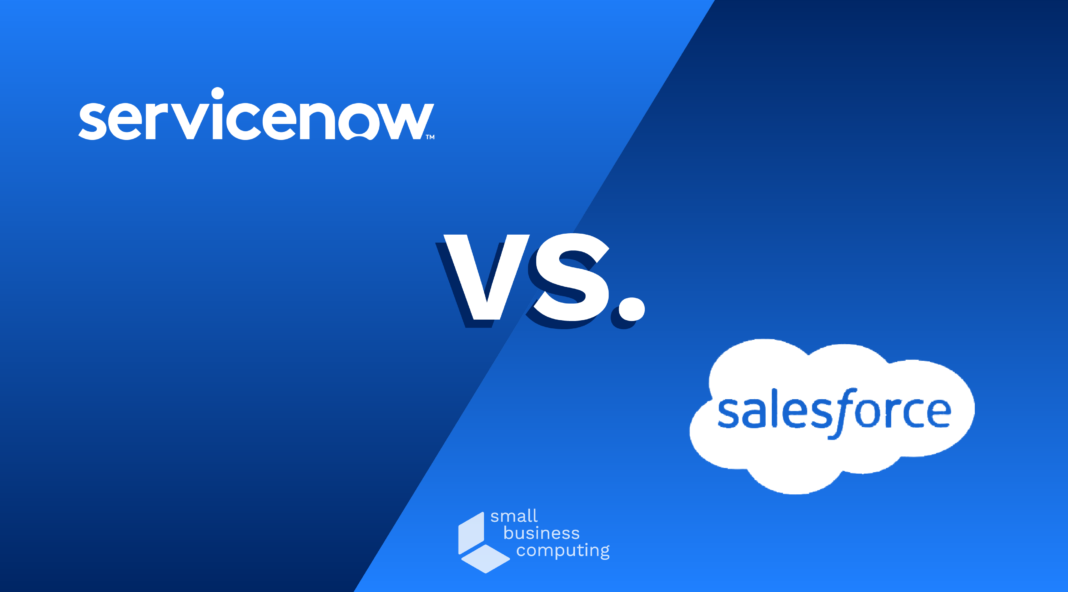Choosing your first or next field service management (FSM) software can be daunting, especially as many of these systems require a huge investment in implementation time and cost. Two of the most popular FSM platforms are ServiceNow and Salesforce Field Service Lightning.
Compare ServiceNow vs. Salesforce Field Service Lightning
- Overview of ServiceNow
- Overview of Salesforce Field Service Lightning
- Major features in common between ServiceNow and Salesforce Field Service Lightning
- Major differences between ServiceNow vs Salesforce Field Service Lightning
- Choosing the best field service management software
Overview of ServiceNow
After coming from the IT service management field for larger enterprise users, ServiceNow has evolved, and today it consolidates several tools and functions to form a unified workflow solution that’s as applicable to field service management as other industries it’s traditionally served.
Though a little harder to learn than many other platforms targeted specifically at SME users, it contains a unified experience from job creation to completion across every department including IT, HR, customer services, sales, security and more.
One of its biggest strengths is the ability to integrate other tools, but ServiceNow’s platform is underpinned by the philosophy of creating a single system record for all processes or jobs across the workflow, letting everyone from users to customers access and action the next step along the pipeline.
Overview of Salesforce Field Service Lightning
Like Kleenex or Sharpie, Salesforce.com is synonymous with its industry sector of customer relationship management (CRM). Because the company’s main focus are tools for the creation, tracking and actioning of cases and tasks, field service management was a natural fit, and there are plenty of dedicated FSM platforms that don’t hold a candle to Salesforce.com even amid all its other products simply because of the strength of the company’s programming resources.
Between recording a customer’s contact details, facilitating and logging all points of contact and interactions with them, managing tasks throughout a workflow and letting customers access and where necessary action data about themselves or their jobs, there are few areas of customer relations Salesforce.com doesn’t already have a very strong offering in, which makes their FMS solution one of the best in the business.
Salesforce’s dedicated FSM tool is called Field Service Lightning, and it lets you create work orders from any case, optimize schedules, and intelligently assign and manage jobs. It’s accessible as a cloud platform through any browser, mobile (Android/iOS), or a Windows-based app, which gives it a lot of reach and popularity across organizations of all sizes and makes it fully accessible to service technicians in the field.
Major features between ServiceNow and Salesforce
As two of the biggest players in the FMS field, both Salesforce.com and ServiceNow have all the essential features well covered. They’re both accessible from any browser on any device and are available as standalone desktop versions or cloud-based deployments. They’re available not just in English but other common languages as well like French, Italian, Dutch and Portuguese.
Because they’ve both proven themselves to be almost endlessly scalable, the customer base of each platform varies wildly but suits everyone from global enterprise users to a single freelance or SME one man band.
Both platforms’ support options are also comprehensive, with phone and online support well appointed as well as the provision for knowledge bases and video tutorials.
Major differences in ServiceNow vs. Salesforce
Salesforce is known for easy data input and access, but customization in Salesforce will likely require the help of a dedicated administrator or developer. Salesforce lets you track assets or equipment, manage accessibility levels and credentials across users, manage the release of products or services and incorporate more comprehensive training than just tutorials and FAQs.
ServiceNow does not include any of these features out of the box. And because of the huge number of other products and platforms in its app ecosystem, Salesforce has more ways to expand and make it your own.
The interfaces are also quite different, with ServiceNow looking like an email browser client like Gmail or Outlook. Salesforce, by contrast, has a more engaging user interface that you can edit to show only the information you need to see depending on your particular job.
Choosing the best field service management software
On balance, Salesforce tends to be a better fit for small companies and start-ups – somewhat ironically given the sheer number of features it puts in your grasp – that have a large number of small client transactions. This makes it perfect for a company that is looking for a software platform than can bring together data and services across several departments.
But both platforms service a larger environment (i.e. over 1,000 employees) just as readily, so at that level it comes down to features and cost. Features are trickier to weigh up – depending on your needs, the far less widely appointed ServiceNow might be perfectly adequate for what you need.
And even though cost seems like no contest (Salesforce.com starts at $25/month versus ServiceNow’s annual fee of a little of $10K at the lowest level), the size and scope of your business might absorb ServiceNow’s much higher fee quite easily if it contains functionality you need that returns a better ROI.
Because the other thing to keep in mind with both platforms is the conventional wisdom among people who’ve done it that it’s neither quick nor cheap, with a whole implementation program in some cases taking six months or more. A dedicated software engineer overseeing the project is said to be a must (which will add to the cost), and if you do it haphazardly or out of sync, the total cost will end up much higher.


